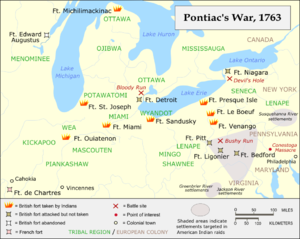Fort Venango
| Fort Venango | |
|---|---|
| Near Franklin, Pennsylvania, United States | |
| Coordinates | 41°23′22″N 79°49′20″W / 41.38932°N 79.82217°W |
| Type | Fort |
| Site information | |
| Controlled by | United Kingdom |
| Site history | |
| Built | 1760 |
| In use | 1760-1763 |
| Materials | Wood |
| Battles/wars | Pontiac's Rebellion |
| Designated | October 10, 1972 |
Fort Venango, a small British fort built in 1760 near the present-day site of Franklin, Pennsylvania, replaced Fort Machault, a French fort built at the confluence of French Creek and the Allegheny River. The French burned Fort Machault in August 1759 after abandoning it. They retreated to the north after learning of the French surrender to the British of Fort Niagara, near the end of the French and Indian War. Fort Venango was built during summer 1760. It was attacked and destroyed in June 1763 during Pontiac's War.
Background[edit]
With the capture of Fort Duquesne by the British in November 1758, and the capture of Fort Niagara in July 1759, the French were forced to withdraw from Pennsylvania, abandoning and burning Fort Machault, Fort Le Boeuf, and Fort Presque Isle in August 1759. General Robert Monckton held a conference with Native American leaders and obtained their permission to build and maintain forts in western Pennsylvania.[1]
Construction[edit]

According to the History of Venango County (1879):
- "At this place an entirely new site was selected, and a new fort erected. Fort Machault was so thoroughly dismantled that there was nothing valuable left. The site for the new work was about forty rods higher up the river, and nearer the mouth of French creek...It was a much more permanent and substantial work than that of the French...The general outline was a square, with bastions projecting from the curtains. The enclosed area was eighty-eight feet square, with a blockhouse in the center. This was surrounded by a ditch twenty-four feet in width. Outside of this was the embankment, about eight feet in width, with bastions of earth on each side, and completely commanding all the angles of the fort."[2]: 65
The British named the fort after the nearby Lenape village, Venango, derived from the Native American name, Onenge, meaning otter.[3]
Destruction, 1763[edit]
On June 16 1763, during Pontiac's War, Fort Venango was captured by Seneca and Mingo warriors[4] led by the Seneca chief Guyasuta,[5] : 8 gaining entrance to the fort by pretending to be unarmed and friendly,[6]: 30 [7]: 64–65 They killed the 12 to 16 soldiers of the fort garrison outright, except for the commander, Lieutenant Francis Gordon. The warriors forced him to write a letter detailing why the Indians had risen against the British. He recorded two complaints: that the British had not supplied the tribes with sufficient gunpowder for the past two years and that the English, contrary to their treaty promises, were keeping forts, and building new forts, in what the Crown had proclaimed to be reserved as exclusively Native American territory west of the Appalachian Mountains. The warriors subjected Gordon to ritual slow torture and burned him to death at the stake.[8]: 167–68 They burnt Fort Venango to the ground.[2]: 65–66
References[edit]
- ^ George Dallas Albert, Report of the Commission to Locate the Site of the Frontier Forts of Pennsylvania, Vol. 1, State Printer of Pennsylvania, 1896
- ^ a b J. H. Newton, ed. History of Venango County, Pennsylvania: And Incidentally of Petroleum, Together with Accounts of the Early Settlement and Progress of Each Township, Borough and Village, with Personal and Biographical Sketches of the Early Settlers, Representative Men, Family Records, Etc. J. A. Caldwell, 1879.
- ^ Charles M. Stotz, Outposts of the War for Empire: The French and English in Western Pennsylvania: Their Armies, Their Forts, Their People, 1749-1764 Pittsburgh, PA: University of Pittsburgh Press, 1985
- ^ "Fort LeBoeuf French and Indian War Museum," Fort Leboeuf Historical Society, 2021
- ^ Harper, Rob. Unsettling the West: Violence and State Building in the Ohio Valley. Philadelphia: University of Pennsylvania Press, 2018; pp 8-9
- ^ Blacksnake., Williams, Benjamin. Chainbreaker: The Revolutionary War Memoirs of Governor Blacksnake as Told to Benjamin Williams. University of Nebraska Press, 2005.
- ^ Draper, Lyman Copeland, Cardinal, Jaré R. Notes Of Border History; Taken on a Trip to the western part of Penna., & the adjoining parts of N. Y. & Ohio. RAJ Publications, 2016.
- ^ Peckham, Howard H. Pontiac and the Indian Uprising, University of Chicago Press; 1947


